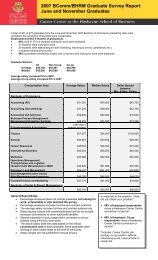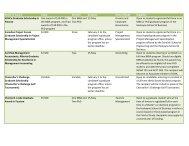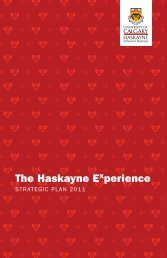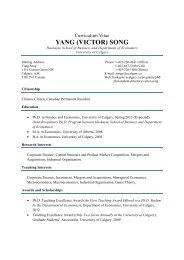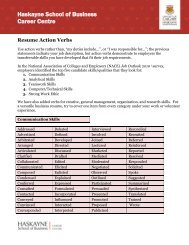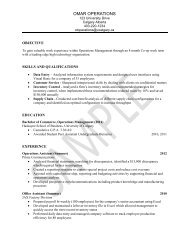The real options approach to valuation - Haskayne School of Business
The real options approach to valuation - Haskayne School of Business
The real options approach to valuation - Haskayne School of Business
You also want an ePaper? Increase the reach of your titles
YUMPU automatically turns print PDFs into web optimized ePapers that Google loves.
<strong>The</strong> Real Op*ons Approach <strong>to</strong> Valua*on: Challenges and Opportuni*es Eduardo Schwartz UCLA Anderson <strong>School</strong> 2012 Alberta Finance Ins*tute Conference
Research on Real Op*ons Valua*on • Mines and Oil Deposits • S<strong>to</strong>chas*c Behavior <strong>of</strong> Commodity Prices • Forestry Resources • Expropria*on Risk in Natural Resources • Research and Development • Internet Companies • Informa*on Technology
Outline <strong>of</strong> Talk • Basic ideas about Real Op*ons Valua*on • Solu*on procedures • Natural resource investments and the s<strong>to</strong>chas*c behavior <strong>of</strong> commodity prices • Research and Development Investments
Basic Ideas about Real Op*ons
Using Real Op*ons • Uncertainty and the firm’s ability <strong>to</strong> respond <strong>to</strong> it (flexibility) are the source <strong>of</strong> value <strong>of</strong> an op*on • When not <strong>to</strong> use <strong>real</strong> op*ons: – When there are no op*ons at all – When there is liXle uncertainty – When consequences <strong>of</strong> uncertainty can be ignored • Most projects are subject <strong>to</strong> op*ons valua*on
Investment Projects as Op*ons 1. Op*on <strong>to</strong> expand a project: Invest in a nega*ve NPV project which gives the op-on <strong>to</strong> develop a new project. 2. Op*on <strong>to</strong> postpone investment: Project may have a posi*ve NPV now, but it might not be op*mal <strong>to</strong> exercise the op-on <strong>to</strong> invest now, but wait un*l we have more informa*on in the future (valua*on <strong>of</strong> mines).
Investment Projects as Op*ons 3. Op*on <strong>to</strong> abandon: Projects are analyzed with a fixed life, but we always have the op-on <strong>to</strong> abandon it if we are loosing money. 4. Op*on <strong>to</strong> temporarily suspend produc*on: open and close facility.
Tradi*onal Valua*on Tools (DCF) • Require forecasts – A single expected value <strong>of</strong> future cash flows is generally used – Difficulty for finding an appropriate discount rate when op*ons (e.g., exit op*on) are present • Future decisions are fixed at the outset – no flexibility for taking decisions during the course <strong>of</strong> the investment project
Risk Neutral Valua*on • Lets first look at one aspect <strong>of</strong> the new <strong>approach</strong> • Tradi*onal vs. Certainty Equivalent <strong>approach</strong> <strong>to</strong> valua*on • Op*ons a liXle later
Tradi*onal Approach: NPV • Risk adjusted discount rateNPV=C0+N∑t = 1 (1 +Ctk)tC tin period t expected cash flow k risk adjusted discount rate
Certainty Equivalent Approach NPV=C0+N∑t = 1 (1 +CEQtr )ftCEQ tcertain cash flow that would be exchanged for risky cash flow (market based)
Simple Example • Consider a simplified valua*on <strong>of</strong> a Mine or Oil Deposit • <strong>The</strong> main uncertainty is in the commodity price and futures markets for the commodity exist (copper, gold, oil) • Brennan and Schwartz (1985) • For the moment neglect op*ons
Tradi*onal vs. CE Valua*on Tradi*onal Valua*on: NPV=C0+NNt t= + ∑t tCt0t= 1 (1 k)t=1 (1 +∑Rev−+CostqS−Costtk)tCertainty Equivalent Valua*on: NPV=C0+Nt tt = 1 (1 +∑qF− Costtr )ft
<strong>The</strong>se Results are General Cox and Ross (1976), Harrison and Kreps (1979) and Harrison and Pliska (1981) show that the absence <strong>of</strong> arbitrage imply the existence <strong>of</strong> a probability distribu*on such that securi*es are priced at their discounted (at the risk free rate) expected cash flows under this risk neutral or risk adjusted probabili*es (Equivalent Mar-ngale Measure). Adjustment for risk is in the probability distribu*on <strong>of</strong> cash flows instead <strong>of</strong> the discount rate (Certainty Equivalent Approach).
• If markets are complete (all risks can be hedged) these probabili*es are unique. • If markets are not complete they are not necessarily unique (any <strong>of</strong> them will determine the same market value). • Futures prices are expected future spot prices under this risk neutral distribu*on. • This applies also when r is s<strong>to</strong>chas*c. VT∫−rf ( t ) dt= EQ[ e0 0 XT]
Op*on Pricing <strong>The</strong>ory introduced the concept <strong>of</strong> pricing by arbitrage methods. • For the purpose <strong>of</strong> valuing op*ons it can be assumed that the expected rate <strong>of</strong> return on the s<strong>to</strong>ck is the risk free rate <strong>of</strong> interest. <strong>The</strong>n, the expected value <strong>of</strong> op*on at maturity (under the new distribu*on) can be discounted at the risk free rate. In this case the market is complete and the EMM is unique.
Using the Risk Neutral Framework <strong>to</strong> value projects allows us <strong>to</strong> • Use all the informa*on contained in futures prices when these prices exist • Take in<strong>to</strong> account all the flexibili*es (op*ons) the projects might have • Use the powerful analy*cal <strong>to</strong>ols developed in con*ngent claims analysis
Real Op*ons Valua*on (1) • Risk neutral distribu*on is known – Black Scholes world – Gold mine is, perhaps, the only pure example <strong>of</strong> this world F 0,T = S 0 (1+r f ) T
True and risk neutral s<strong>to</strong>chas*c process for Gold prices dS= µ dt + σdzSdz ≈ N(0,dt)dS= rdt + σdz~Sdz ~ ≈ N(0,dt)
Real Op*ons Valua*on (2) • Risk neutral distribu*on can be obtained from futures prices or other traded assets – Copper mine, oil deposits • Challenges – Future prices are available only for short *me periods: in Copper up <strong>to</strong> 5 years – Copper mines can last 50 years! • <strong>The</strong> models fit prices and dynamics very well for maturi*es <strong>of</strong> available futures prices
Real Op*ons Valua*on (3) • Need an equilibrium model (CAPM) <strong>to</strong> obtain risk neutral distribu*on because there are no futures prices – R&D projects – Internet companies – Informa*on technology
Summary: Real Op*ons Valua*on • For many projects, flexibility can be an important component <strong>of</strong> value • <strong>The</strong> op*on pricing framework gives us a powerful <strong>to</strong>ol <strong>to</strong> analyze those flexibili*es • <strong>The</strong> <strong>real</strong> op*ons <strong>approach</strong> <strong>to</strong> valua*on is being applied in prac*ce • <strong>The</strong> <strong>approach</strong> is being extended <strong>to</strong> take in<strong>to</strong> account compe**ve interac*ons (impact <strong>of</strong> compe**on on exercise strategies)
Solu*on Procedures
Solu*on Methods (1) • Dynamic Programming <strong>approach</strong> – lays out possible future outcomes and folds back the value <strong>of</strong> the op*mal future strategy – binomial method • widely used <strong>of</strong> pricing simple op*ons • good for pricing American type op*ons • not so good when there are many state variables or there are path dependencies – Need <strong>to</strong> use the risk neutral distribu*on
Solu*on Methods (2) • Par*al differen*al equa*on (PDE) – has closed form solu*on in very few cases • BS equa*on for European calls – generally solved by numerical methods • very flexible • good for American op*ons • for path dependencies need <strong>to</strong> add variables • not good for problems with more than three fac<strong>to</strong>rs • technically more sophis*cated (need <strong>to</strong> approximate boundary condi*ons)
Solu*on Methods (3) • Simula*on <strong>approach</strong> – averages the value <strong>of</strong> the op*mal strategy at the decision date for thousands <strong>of</strong> possible outcomes – very powerful <strong>approach</strong> • easily applied <strong>to</strong> mul*-‐fac<strong>to</strong>r models • directly applicable <strong>to</strong> path dependent problems • can be used with general s<strong>to</strong>chas*c processes • intui*ve, transparent, flexible and easily implemented – But it is forward looking, whereas op*mal exercise <strong>of</strong> American op*ons has features <strong>of</strong> dynamic programming
Valuing American Op*ons by Simula*on: A simple least-‐squares <strong>approach</strong> • Longstaff and Schwartz, 2001 • An American op*on gives the holder the right <strong>to</strong> exercise at mul*ple points in *me (finite number). • At each exercise point, the holder op*mally compares the immediate exercise value with the value <strong>of</strong> con*nua*on. • Standard theory implies that the value <strong>of</strong> con*nua*on can be expressed as the condi*onal expected value <strong>of</strong> discounted future cash flows. 29
Valuing American Op*ons by Simula*on: A simple least-‐squares <strong>approach</strong> • This condi*onal expecta*on is the key <strong>to</strong> being able <strong>to</strong> make op*mal exercise decisions. • Main idea <strong>of</strong> the <strong>approach</strong> is that the condi*onal expected value <strong>of</strong> con*nua*on can be es*mated from the cross-‐sec*onal informa*on from the simula*on by least squares. 30
Valuing American Op*ons by Simula*on: A simple least-‐squares <strong>approach</strong> • We es*mate the condi*onal expecta*on func*on by regressing discounted ex post cash flows from con*nuing on func*ons <strong>of</strong> the current (or past) values <strong>of</strong> the state variables. • <strong>The</strong> fiXed value from this cross-‐sec*onal regression is an efficient es*ma<strong>to</strong>r <strong>of</strong> the condi*onal expecta*on func*on. It allows us <strong>to</strong> accurately es*mate the op*mal s<strong>to</strong>pping rule for the op*on, and hence its current value.
Natural Resource Investments
Three Fac<strong>to</strong>r Model: Actual (Cortazar and Schwartz (2003)) dS=( ν − y) Sdt + σ11Sdzdy= −κ ydt +σ2dz 2( ν ν ) dt σ 3 dz 3dν= a − +
Three Fac<strong>to</strong>r Model: Risk Neutral dSdy( )∗ν − y − λ Sdt + σ=1 1Sdz1( )∗−κy− λ dt + σ= 2 2dz2( ν ν ) λ dt σ*dν= ( a − − + dz3 )33We need <strong>to</strong> make assumptions about the functionalform <strong>of</strong> the market prices <strong>of</strong> risks
30.00Oil Futures 01/08/99Three-Fac<strong>to</strong>r Model25.0020.00Price (US$)15.00ObservedModel10.005.000.000 1 2 3 4 5 6 7 8 9 10Maturity (Years)
40Oil Futures 10/12/00Three-Fac<strong>to</strong>r Model3530ObservedModel25Price (US$)201510500 1 2 3 4 5 6 7 8 9 10Maturity (Years)
What <strong>to</strong> do for longer maturi*es? • Accept the model predic*ons for maturi*es where there are no futures prices? • Maybe a few years only? • Assume flat futures prices? • Assume futures prices increase at a fixed rate (infla*on?)? • Since there is more uncertainty in this area, what discount rate <strong>to</strong> use (risk free rate?)?
Recent work on Commodi*es • Two recent papers with Anders Trolle • “Unspanned s<strong>to</strong>chas*c vola*lity and the pricing <strong>of</strong> commodity deriva*ves” (2009) • “Pricing expropria*on risk in natural resource contracts – A <strong>real</strong> op*ons <strong>approach</strong>” (2010)
NYMEX crude-‐oil futures and op*on data • Largest and most liquid commodity deriva*ves market in the world • Largest range <strong>of</strong> maturi*es and strike prices, which vary significantly during the sample period • Daily data from Jan 2, 1990 <strong>to</strong> May 18, 2006 • We choose the 12 most liquid contracts for the analysis M1, M2, M3, M4, M5, M6 (first 6 monthly contracts) Q1, Q2 (next two quarterly contracts expiring in Mar, Jun, Sep or Dec) Y1, Y2, Y3, Y4 (next four yearly contracts expiring in Dec)
Evidence <strong>of</strong> unspanned s<strong>to</strong>chas*c vola*lity • If we regress changes in vola*lity on the returns <strong>of</strong> futures contracts (or its PC), the R2 will indicate the extent <strong>to</strong> which vola*lity is spanned • But vola*lity is not directly observable • Return on Straddles: Call + Put with the same strike (closest <strong>to</strong> ATM); low “deltas” and high “vegas”. Model independent • Changes in log normal implied vola*li*es: average expected vola*lity over the life <strong>of</strong> the op*on
Procedure • We fac<strong>to</strong>r analyze the covariance matrix <strong>of</strong> the futures returns and retain the first three principal components (PCs) • Regress straddle returns (changes in implied vola*li*es) on PCs and PCs squared • We find that the R2 are typically very low, especially for the implied vola*lity regressions (between 0 and 21%)
Procedure • Thus, fac<strong>to</strong>rs that explain futures returns cannot explain changes in vola*lity • We then fac<strong>to</strong>r analyze the covariance matrix <strong>of</strong> the residuals from these regressions. If there is unspanned s<strong>to</strong>chas*c vola*lity in the data we should see large common varia*on in the residuals • We find that typically the first two PC explain over 80% <strong>of</strong> the varia*on in the residuals
Two Vola*lity Fac<strong>to</strong>rs (SV2)
Pricing expropria*on risk in natural resource contracts • Conference on “<strong>The</strong> Natural Resources Trap, Private Investment without Public Commitment ” (Kennedy <strong>School</strong>, Harvard) • <strong>The</strong>re are many dimensions <strong>to</strong> the study <strong>of</strong> expropria*on risk in natural resource investments: poli*cal, environmental, sociological, economic • In our <strong>approach</strong> we abstract from many <strong>of</strong> these issues and we concentrate on some <strong>of</strong> the important economic trade-‐<strong>of</strong>fs that arise from a government having an “op*on” <strong>to</strong> expropriate the resource
Expropria*on Op*on • We value a natural resource project, in par*cular an oil field, exposed <strong>to</strong> expropria*on risk • We view the government as holding an op*on <strong>to</strong> expropriate the oil field
Expropria*on Trade-‐<strong>of</strong>f • Government faces the following trade-‐<strong>of</strong>f in expropria*on (think about Argen*na vs YPF) – Benefit: • receives all pr<strong>of</strong>its rather than a frac*on through taxes – Costs: • Private firm may produce oil more efficiently • Government may have <strong>to</strong> pay compensa*on <strong>to</strong> the firm • Government faces “reputa*onal” costs
Assump*ons • We abstract from the various opera*onal op*ons that are typically embedded in natural resource projects and concentrate on the expropria*on op*on • Spot prices, futures prices and vola*li*es are described by the one vola*lity fac<strong>to</strong>r model (SV1)
Solu*on Procedure • Expropria*on op*on can be exercised at any *me during the life <strong>of</strong> the op*on: American-‐style (LSM) • At every point in *me the government must compare the value <strong>of</strong> immediate exercise with the condi*onal expected value (under the risk neutral measure) <strong>of</strong> con*nua*on • Outcome is the op*mal exercise *me for each simulated path which can be used <strong>to</strong> value the expropria*on op*on • We can also es*mate the value <strong>of</strong> the oil field <strong>to</strong> the government and the firm both in the presence and absence <strong>of</strong> expropria*on risk
Main Results • For a given contractual arrangement the value <strong>of</strong> the expropria*on op*on increases with – <strong>The</strong> spot price – <strong>The</strong> slope <strong>of</strong> the futures curve (contango, backwarda*on) – <strong>The</strong> vola*lity <strong>of</strong> the spot (futures) price • For a given set <strong>of</strong> state variables the value <strong>of</strong> the expropria*on op*on decreases with the – Tax rate – Various expropria*on costs • <strong>The</strong> increase in the field’s value <strong>to</strong> the government due <strong>to</strong> expropria*on risk is always smaller than the decrease in the field value <strong>to</strong> the firms, since there are “deadweight losses” associated with expropria*on (produc*on inefficiency and “reputa*onal costs”)
R&D Investments Focus has been the pharmaceutical industryFramework, however, applies just as well <strong>to</strong>other research-intensive industries
R&D Investments • <strong>The</strong> pharmaceu*cal industry has become a research-oriented sec<strong>to</strong>r that makes a major contribu*on <strong>to</strong> health care. • <strong>The</strong> success <strong>of</strong> the industry in genera*ng a stream <strong>of</strong> new drugs with important therapeu*c benefits has created an intense public policy debate over issues such as – the financing <strong>of</strong> the cost <strong>of</strong> research – the prices charged for its products – the socially op*mal degree <strong>of</strong> patent protec*on
• <strong>The</strong>re is a trade-‐<strong>of</strong>f between promo*ng innova*ve efforts and securing compe**ve market outcomes. • <strong>The</strong> expected monopoly pr<strong>of</strong>its from drug sales during the life <strong>of</strong> the patent compensate the innova<strong>to</strong>r for its risky investment. • <strong>The</strong> onset <strong>of</strong> compe**on aVer the expira*on <strong>of</strong> the patent limits the deadweight losses <strong>to</strong> society that arise from monopoly pricing under the patent. • Regula*on has had important effects on the cost <strong>of</strong> innova*on in the pharmaceu*cal industry.
Analysis <strong>of</strong> R&D projects is a very difficult investment problem • Takes a long *me <strong>to</strong> complete • Uncertainty about costs <strong>of</strong> development and *me <strong>to</strong> comple*on • High probability <strong>of</strong> failure (for technical or economic reasons) • Drug requires approval by the FDA • Uncertainty about level and dura*on <strong>of</strong> future cash flows • Abandonment op*on is very valuable
TuVs Center for the Study <strong>of</strong> Drug Development (December 2001) • Average development *me for new drugs: 12 years • Average <strong>to</strong>tal drug research costs (millions) Out-‐<strong>of</strong>-‐pocket expenses: Including cost <strong>of</strong> capital (11%): $802 – Calculated at *me <strong>of</strong> marke*ng <strong>of</strong> drug $403 – Includes cost <strong>of</strong> failed drugs (20% success) • More recent figures go up <strong>to</strong> $4 billion per drug • Yearly US expenditures in prescrip*on drugs :$308 billion (2010)
Research Spending Per New Drug Company Ticker Number <strong>of</strong>drugs approved R&D SpendingPer Drug ($Mil) Total R&DSpending1997-2011($Mil) AstraZeneca AZN 5 11,790.93 58,955 GlaxoSmithKline GSK 10 8,170.81 81,708 San<strong>of</strong>i SNY 8 7,909.26 63,274 RocheHolding AG RHHBY 11 7,803.77 85,841 Pfizer Inc. PFE 14 7,727.03 108,178 Johnson &Johnson JNJ 15 5,885.65 88,285 Eli Lilly & Co. LLY 11 4,577.04 50,347 AbbottLabora<strong>to</strong>ries ABT 8 4,496.21 35,970 Merck & Co Inc MRK 16 4,209.99 67,360 Bris<strong>to</strong>l-MyersSquibb Co. BMY 11 4,152.26 45,675 Novartis AG NVS 21 3,983.13 83,646 Amgen Inc. AMGN 9 3,692.14 33,229 Sources: InnoThink Center For Research In Biomedical Innovation; ThomsonReuters Fundamentals via FactSet Research Systems
Pfizer ‘Youth Pill’ Ate Up $71 Million Before It Flopped (WSJ: May 2, 2002) • <strong>The</strong> experimental drug aimed <strong>to</strong> reverse the physical decline that comes with aging. • Nearly a decade <strong>of</strong> research. • Pa*ents taking the frailty drug had gained some muscle mass – but less than 3% more than the placebo group – which also experienced muscle increase. • Drug appeared ineffec*ve.
Mediva*on, Pfizer end work on Alzheimer’s Drug (WSJ: January 18, 2012 • In 2008 Pfizer agreed <strong>to</strong> pay $225 million upfront – and up <strong>to</strong> $500 million if successful – for development rights <strong>to</strong> Dimebon. • Some 5.4 million in the US and 18 million worldwide are es*mated <strong>to</strong> have Alzheimer’s • Analysts say that effec*ve treatment could reach $25 billion per year
Success s<strong>to</strong>ry: Lipi<strong>to</strong>r from Pfizer • Most prescribed name-‐brand in the US with 3.5 million people taking it every day • Enter the market in 1997 and loss patent protec*on at the end <strong>of</strong> Nov. 2011 with <strong>to</strong>tal sales <strong>of</strong> $81 billion • But (WSJ May 2, 2112), Pfizer's first-‐quarter pr<strong>of</strong>it declined 19% as sales <strong>of</strong> its <strong>to</strong>p product, Lipi<strong>to</strong>r, tumbled 71% in the U.S. amid compe**on from generic copies.
R&D Valua*on 1. Evalua*on <strong>of</strong> Research and Development Investments (with M. Moon, 2000) 2. Patents and R&D as Real Op*ons (2004) 3. R&D Investments with Compe**ve Interac*ons (with K. Miltersen, 2004) 4. A Model <strong>of</strong> R&D Valua*on and the Design <strong>of</strong> Research Incen*ves (with J. Hsu, 2008)
Patents and R&D as Real Op*ons • Methodology for the valua*on <strong>of</strong> a single R&D project that is patent protected • Or equivalently, for determining the value <strong>of</strong> a patent <strong>to</strong> develop a par*cular product
Real Op*ons Approach • Treat the patent protected R&D project or the patent as a complex op*on on the variables underlying the value <strong>of</strong> the project – expected costs <strong>to</strong> comple*on – an*cipated cash flows • Uncertainty is introduced in the analysis by allowing these variables <strong>to</strong> follow s<strong>to</strong>chas*c processes through *me • <strong>The</strong> risk adjusted process for the cash flows is obtained using the “beta” <strong>of</strong> traded pharmaceu*cal companies
Approach • R&D project takes *me <strong>to</strong> complete • Maximum rate <strong>of</strong> investment • Total cost <strong>to</strong> comple*on is random variable • Probability <strong>of</strong> failure (catastrophic events) • Op*on <strong>to</strong> abandon the project • When, and if, project is completed cash flows start <strong>to</strong> be generated • Cash flows are uncertain (level and dura*on) • Project is patent protected un*l *me T
Patent-protected R&D ProjectInvest K at rate IReceive CTerminal value0τT
Investment Cost Uncertainty Expected cost <strong>to</strong> comple*on follows (technical uncertainty): 2dK = −Idt+ σ ( IK)1dzVariance <strong>of</strong> cost <strong>to</strong> comple*on:~Var(K)=σ2K2 −σ22λ :Poisson Pr obability<strong>of</strong>Failure
Cash Flow Uncertainty Cash flow rate follows Geometric Brownian mo*on which may be correlated with cost process: dC= α Cdt +φCdwRisk adjusted process used for valua*on: dC= ( α −η)Cdt + φCdw= α * Cdt +φCdw
Value <strong>of</strong> Project once Investment has been Completed: V(C,t) 1 22φ C2VCC+ α * CV + V − rV + CCt=0Subject <strong>to</strong> boundary condi*on at expira*on <strong>of</strong> the patent: V( C,T)=M• CHas solu*on: CV ( C,t)= [1 − exp( −(r −α*)(T − t))]+ MC exp( −(r − *)( T − t))r −α*α
S<strong>to</strong>chas*c process for the (true) return on the project once investment is completed dVV= ( r +η ) dt + φdwVola*lity and risk premium are the same as for cash flows. Assuming the ICAPM holds the risk premium is: η = β ( r − r) m
Value <strong>of</strong> the Investment Opportunity: F(C,K,t) MaxI1 2 2 1 22[ φ C FCC+ σ ( IK)FKK+ φσρC(IK)2 2IF + F − ( r + λ)F − I]= 0Kt1FCK+ α * CFC−Subject <strong>to</strong> boundary condi*on at comple*on <strong>of</strong> investment: F ( C,0,τ ) = V ( C,τ )Problem with this is that *me <strong>of</strong> comple*on is random.
Figure 4:Critical Values for InvestmentCash Flow Rate18.0017.0016.0015.0014.0013.0012.0011.0010.009.00Invest at Maximum RateDo not InvestProject Value Equal 08.0080.00 85.00 90.00 95.00 100.00 105.00 110.00 115.00 120.00Cost <strong>to</strong> Completion
R&D Investments with Compe**ve Interac*ons (joint with K. Miltersen) • Concentrates on compe**ve interac*ons and the effect it has on valua*on and op*mal investment strategies • Real op*ons framework is extended <strong>to</strong> incorporate game theore*cal concepts • Two firms inves*ng in R&D for different drugs both targeted <strong>to</strong> cure the same disease • If both firms successful: Duopoly pr<strong>of</strong>its in marke*ng phase. But it can affect decisions in development phase. Decisions in development phase affects outcome in marke*ng phase
Compe**on in R&D projects • Compe**on brings about – Higher produc*on at lower prices – Higher probability <strong>of</strong> success – Shorter average development *me • But with higher <strong>to</strong>tal development costs and lower values <strong>to</strong> firms
A Model <strong>of</strong> R&D Valua*on and the Design <strong>of</strong> Research Incen*ves (joint with J. Hsu) • Malaria, Tuberculosis, and African strains <strong>of</strong> HIV kill more than 5 million people each year • Almost all <strong>of</strong> the death occur in the developing world • Very liXle private pharmaceu*cal investment devoted <strong>to</strong> researching vaccines for these diseases • A small market problem—people in the developing countries can’t afford <strong>to</strong> pay • Interna*onal organiza*ons and private founda*ons willing <strong>to</strong> provide funding (WHO, Gates Founda*on)
Current Literature on “Encouraging Pharmaceu*cal Innova*on” • Kremer (2001, 2002) review popular subsidy programs • Push programs: subsidize the cost <strong>of</strong> the R&D – Research grant – Co-‐payment • Pull programs: subsidize the revenue <strong>of</strong> the R&D – Purchase commitment – Tax incen*ve – Extended patent protec*on
Current Literature • No analy*cal framework for contras*ng the different incen*ve programs <strong>The</strong> Contribu*on • Develop a <strong>real</strong> op*ons valua*on model for general R&D • Examine the different incen*ve programs quan*ta*vely using the valua*on framework
What’s new in this paper? • Quality <strong>of</strong> the R&D output is modeled explicitly • Revenue is a func*on <strong>of</strong> – the quality – the firm’s pricing (and quan*ty) strategy – Market demand • Firm’s price and quan*ty strategy could depend on – Incen*ve program in place – Monopoly power
Analyzing Incen*ve Contracts • Push Contracts: – Full discre*onary research grant – Sponsor co-‐payment • Pull Contracts: – Extended patent protec*on – Fixed price purchase commitment – Variable price purchase commitment
Contract Specifics • Developer retains right, supplies monopoly quan*ty – Full discre*onary research grant – Sponsor co-‐payment – Patent extension • Sponsor can contract the socially op*mal quan*ty <strong>to</strong> be produced – Purchase commitment contracts • We abstract from agency problem arising from asymmetric informa*on between vaccine developer and sponsor, and from contrac*ng issues
We seek <strong>to</strong> answer five cri*cal ques*ons • What is the required level <strong>of</strong> monetary incen*ve <strong>to</strong> induce the firm <strong>to</strong> undertake the vaccine R&D? • What are the expected price, quan*ty supplied and efficacy <strong>of</strong> the developed vaccine? • What is the probability that a viable vaccine will be developed? • What is the consumer surplus generated? • What is the expected cost per individual successfully vaccinated?



